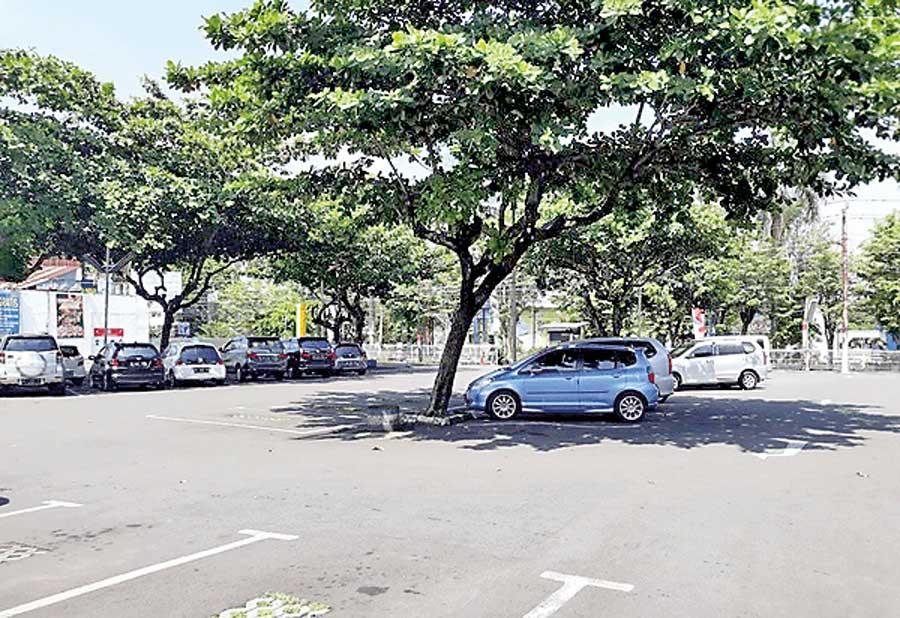09 Feb 2024 - {{hitsCtrl.values.hits}}

Recent studies have shown that the surface temperature in car parks in Colombo can go over 400C during daytime. The high surface temperatures can be reduced by 40C to 50C by introducing tree canopies for shading. Existing car parks could also be converted into green car parks with minimal intervention while retaining the number of parking slots if they are planned with care
The number of vehicles in use worldwide is projected to double by 2040, leading to an increase in demand for car parks. Sri Lanka too faces a similar situation due to a poor public transport system, which creates heavy dependence on private vehicles for the daily travels of the general public. As the number of private vehicles on the roads increased, so has the need for parking spaces, particularly in areas where on-street parking is limited or prohibited. To facilitate the vehicles, the provision of car parks is mandatory in commercial developments in urban areas in the country.
transport system, which creates heavy dependence on private vehicles for the daily travels of the general public. As the number of private vehicles on the roads increased, so has the need for parking spaces, particularly in areas where on-street parking is limited or prohibited. To facilitate the vehicles, the provision of car parks is mandatory in commercial developments in urban areas in the country.
To address these challenges, the Sri Lankan government and private sector have taken a number of steps, such as building multi-level parking structures, promoting the use of public transportation, and implementing smart parking solutions. Despite the use of efficient parking solutions, there are many open car parks being built for public buildings, supermarkets, recreational spaces and commercial buildings at the ground level. In the tropical regions, the construction of open car parks has an impact on the local environment and ecosystems, particularly if they are built on natural habitats or green spaces. It is therefore important to balance the need for parking with sustainable land-use practices and environmental conservation.
The Urban Heat Island Effect
One of the main issues of open car parks is it contributes to the Urban Heat Island (UHI) effect. The urban heat island effect refers to the phenomenon where urban areas experience higher temperatures than surrounding rural areas due to the concentration of human activities, buildings and other infrastructure, which absorb and re-emit heat.The urban heat island effect can have various negative impacts on human health and the environment, including increased heat-related illnesses, reduced air quality, and increased energy consumption for cooling buildings. Therefore, it is important to implement sustainable urban design and planning that incorporate green spaces and vegetation, as well as materials and technologies that can mitigate the Urban Heat Island effect.
Many studies have found significant Urban Heat Island effects in Colombo, due to the increasing of hard surfaces and receding green spaces in the city. The green cover of the Colombo city declined from 35.67% to 22.23% from 1956 to 2010 and is continuing to decrease. These numbers are alarming when compared to the 46.5% greencover in Singapore in 2020. The lack of protection for public green spaces and the limited attention for increasing green spaces in private properties in the current Building and Planning regulations contribute to the receding greenery in Colombo.
Trees such as Pongamia pinnata (Magul karanda) and Cassia fistuala (Ehela) could be optimum choices as they do not bear large fruits and spread extensive roots. Rather than constructing lifeless car parks, they could be created as replacement eco-systems for lost habitats in the cities
The Green Transformation
The importance of green spaces for the health and wellbeing of people is obvious. The air we breathe is directly affected by the amount of vegetation around us. Many studies show that increasing vegetation in cities improves the air quality by not only increasing oxygen levels but also by controlling the air pollution. Ironically, the Colombo city, which has prime residential properties does not have prime air quality. In addition to the impacts on the physical wellbeing, the view and access to green spaces also offer mental satisfaction to many. Being in lush green spaces promotes physical exercise and socializing than in built spaces. The World Health Organisation and the European Environmental Agency both have established standards to maintain green spaces in cities. However, it is up to the local urban planning authorities to implement regulations to ensure access to green space for the public.
Sustainable Open Car Parks
Car parks are a vital part of the country’s transport mechanism. Currently, many car parks are unsightly and cause environmental problems. Therefore, it is important to consider designing sustainable car parks taking into concern the effects on the eco-systems, Urban Heat Island effect and increasing vegetation. Even though urban planning and building regulations in Sri Lanka require adequate parking space, they do not require the car parks to be designed sustainably. Therefore, we find many open car parks, devoid of vegetation and overheating from direct sunlight during daytime. Recent studies have shown that the surface temperature in car parks in Colombo can go over 400C during daytime. The high surface temperatures can be reduced by 40C to 50C by introducing tree canopies for shading. Existing car parks could also be converted into green car parks with minimal intervention while retaining the number of parking slots if they are planned with care. Trees such as Pongamia pinnata (Magulkaranda) and Cassia fistuala (Ehela) could be optimum choices as they do not bear large fruits and spread extensive roots. Rather than constructing lifeless car parks, they could be created as replacement eco-systems for lost habitats in the cities. Greening the open car parks is a simple action that could have a considerable positive effect on the urban environment, leading the way for a greener Colombo.
04 Jan 2025 3 hours ago
04 Jan 2025 3 hours ago
04 Jan 2025 4 hours ago
04 Jan 2025 4 hours ago
04 Jan 2025 5 hours ago